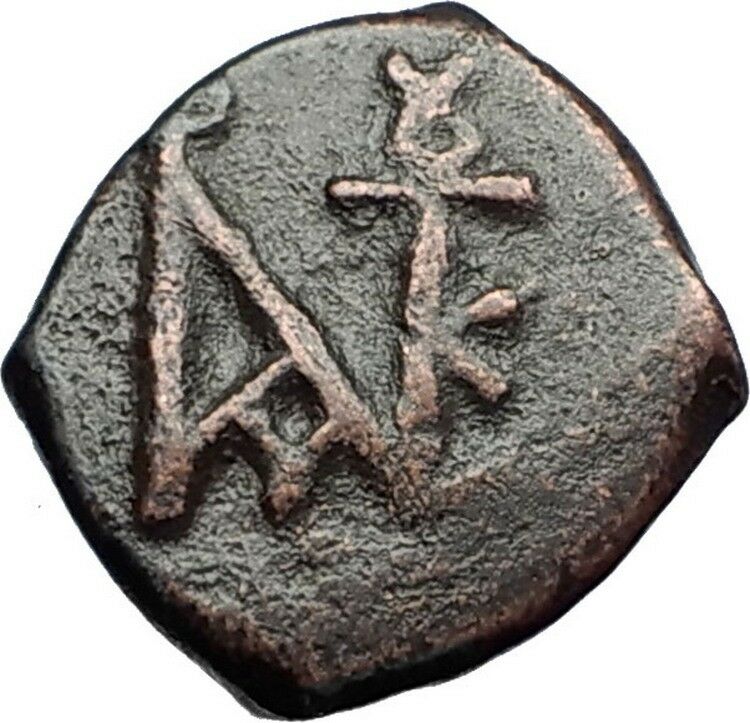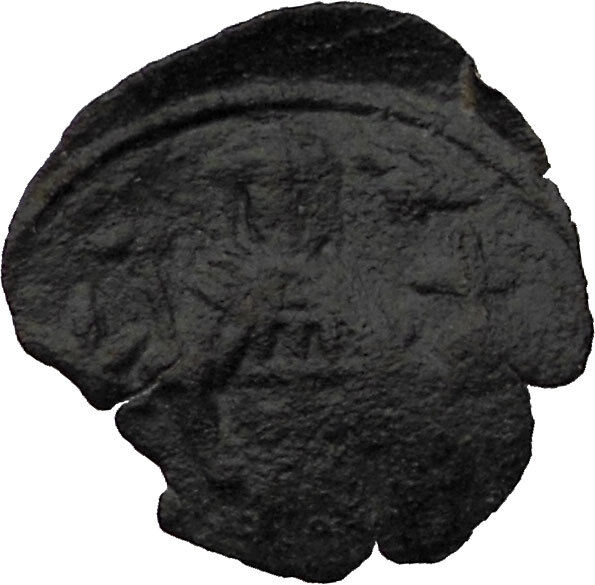|
Byzantine – Constantine VII, Porphyrogenitus – Emperor:
June 6, 913 A.D. – November 9, 959 A.D.
Bronze Follis 29mm (12.55 grams) Struck 913-959 A.D.
Reference: Sear 1761
+ COnST’ bASIL’ ROm’ . – Facing bust of Constantine VII, with short beard,
wearing crown and vertical loros, and holding akakia and globe cross.
+ COnST’ / Єn ΘЄO bA / SILЄVS R / OmЄOn in four
lines.
You are bidding on the exact item pictured,
provided with a Certificate of Authenticity and Lifetime Guarantee of
Authenticity.
Constantine VII Porphyrogennetos or
Porphyrogenitus
, “the
Purple-born
” (Greek:
Κωνσταντίνος Ζ΄ Πορφυρογέννητος, Kōnstantinos
VII Porphyrogennētos), (September 2, 905 – November 9, 959) was the
son of the
Byzantine emperor
Leo VI and his
fourth wife
Zoe
Karbonopsina
. He was also the nephew of the Emperor
Alexander
. He is famous for his four descriptive books,
De Administrando Imperio
,
De
Ceremoniis
,
De Thematibus
and
Vita Basilii
.
His
nickname
alludes to the Purple Room of the imperial palace, decorated with
the stone
porphyry
, where legitimate children of reigning emperors were normally born.
Constantine was also born in this room, although his mother Zoe had not been
married to Leo at that time. Nevertheless, the epithet allowed him to underline
his position as the legitimized son, as opposed to all others who claimed the
throne during his lifetime. Sons born to a reigning Emperor held precedence in
the Byzantine line of ascension over elder sons not
born “in the
purple”
.
//
Reign
Constantine was born at
Constantinople
, an illegitimate son born before an uncanonical fourth
marriage. To help legitimize him, his mother gave birth to him in the Purple
Room of the imperial palace, hence his nickname Porphyrogennetos. He was
symbolically elevated to the throne as a two-year-old child by his father and
uncle on May 15, 908. After the death of his uncle Alexander in 913 and the
failure of the usurpation of
Constantine Doukas
, he succeeded to the throne at the age of seven, under
the regency of the
Patriarch
Nicholas
Mystikos
.
His regent was presently forced to make peace with
Tsar
Simeonn
of Bulgaria
, whom he reluctantly recognized as Bulgarian emperor. Because of
this unpopular concession, Nicholas was driven out of the regency by
Constantine’s mother
Zoe
Zoe was no more successful with the Bulgarians, by whom her main supporter,
the general Leo Phokas
, was defeated in 917, and in 919 she was replaced by the
admiral
Romanos Lekapenos
, who married his daughter
Helena Lekapene
to Constantine. Romanos used his position to advance to the
ranks of
basileopatōr
in May 919, kaisar (Caesar) in
September 920, and finally co-emperor in December of the same year. Thus, just
short of reaching nominal majority, Constantine was again eclipsed by a senior
emperor.
Constantine’s youth had been a sad one for his unpleasant appearance, his
taciturn nature and his relegation at the third level of succession behind the
eldest son of Romanos I Lekapenos. Nevertheless, he was a very intelligent young
man with a large range of interests, and dedicated those years to study the
court’s ceremonial.
Romanos kept power for himself and maintained it until 944, when he was
deposed by his sons Stephen and Constantine. Romanos spent the last years of his
life in exile on the Island of
Prote
as a monk and died on June 15, 948.[1]
With the help of his wife, Constantine VII succeeded in removing his
brothers-in-law and on January 27, 945, Constantine VII was once again sole
emperor at the age of 39, after a life spent in the shadow. Several months
later, Constantine VII crowned his own son
Romanos II
co-emperor. Having never exercised executive authority, Constantine remained
primarily devoted to his scholarly pursuits and relegated his authority to
bureaucrats and generals, as well as his energetic wife Helena Lekapene.
In 949 Constantine launched a new fleet of 100 ships (20
dromons
, 64
chelandia, and 10 galleys) against the
Arab
corsairs hiding in
Crete
, but like
his father’s attempt to retake the island in 911, this attempt also failed. On
the Eastern frontier things went better, even if with alternate success: in 949
the Byzantines conquered
Germanicea
, repeatedly defeated the enemy armies and in 952 crossed the
upper Euphrates
. But in 953 the
Arab
amir
Sayf
al-Daula
retook Germanicea and entered the imperial territory. The land in
the east was eventually recovered by
Nikephoros Phokas
,
who conquered
Hadath
, in northern
Syria
, in 958,
and by the Armenian
general
John Tzimiskes
, who one year later captured
Samosata
,
in northern
Mesopotamiaa
. An Arab fleet was also destroyed by
Greek fire
in 957. Constantine’s efforts to retake themes lost to the Arabs were the first
such efforts to have any real success.
Constantine had intense diplomatic relationships with foreign courts,
including the caliph
of
Cordoba
Abd ar-Rahman III and
Otto I
,
King of Germany
. In the autumn of 957 Constantine was visited by
Olga
,
princess of the
Kievan Rus’
. The reasons for this voyage have never been clarified: in any
case, she was baptised with the name Helena, and began to convert her people to
Christianity
.
Constantine VII died at Constantinople in November 959 and was succeeded by
his son Romanos II
. It was rumored that Constantine had been poisoned by his son or
his daughter-in-law
Theophano
.
Literary
and political activity
Constantine VII was renowned for his abilities as a writer and scholar. He
wrote, or had commissioned, the works
De
cerimoniis aulae byzantinae
(“On Ceremonies”), describing the kinds of
court ceremonies also described later in a more negative light by
Liutprand of Cremona
;
De Administrando Imperio
(“On the Administration of the Empire”), giving
advice on running the empire internally and also how to fight external enemies;
and a history of the Empire covering events following the death of the
chronographer
Theophanes the Confessor
in 817. Amongst his historical works was a history
eulogising the reign and achievements of his grandfather,
Basil I
.
These books are insightful and are of immense interest to the historian,
sociologist and anthropologist as a most useful source of information about
nations neighbouring with Byzantium. They also offer a fine insight into the
Emperor himself.
In his book, A Short History of Byzantium,
John
Julius Norwich
refers to Constantine VII as “The Scholar Emperor” (180).
Norwich states, “He was, we are told, a passionate collector—not only of books
and manuscripts but works of art of every kind; more remarkable still for a man
of his class, he seems to have been an excellent painter. He was the most
generous of patrons—to writers and scholars, artists and craftsmen. Finally, he
was an excellent Emperor: a competent, conscientious and hard-working
administrator and an inspired picker of men, whose appointments to military,
naval, ecclesiastical, civil and academic posts were both imaginative and
successful. He did much to develop higher education and took a special interest
in the administration of justice (181). In 947, Constantine VII ordered the
immediate restitution, without compensation, of all peasant lands, thus, by the
end of [his] reign, the condition of the landed peasantry—which formed the
foundation of the whole economic and military strength of the Empire—was better
off than it had been for a century” (182-3).
By his wife
Helena Lekapene
, the daughter of Emperor
Romanos I
,
Constantine VII had several children, including:
- Leo, who died young.
- Romanos II
.
- Zoe. Sent to a convent.
-
Theodora
, who married Emperor
John I Tzimiskes
.
- Agatha. Sent to a convent.
-
Theophano
, daughter in-law.
- Theophano. Sent to a convent.
- Anna. Sent to a convent..
|







